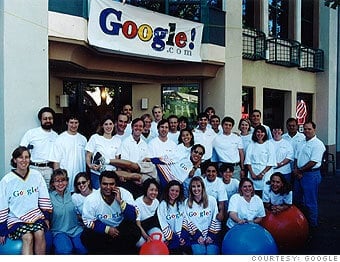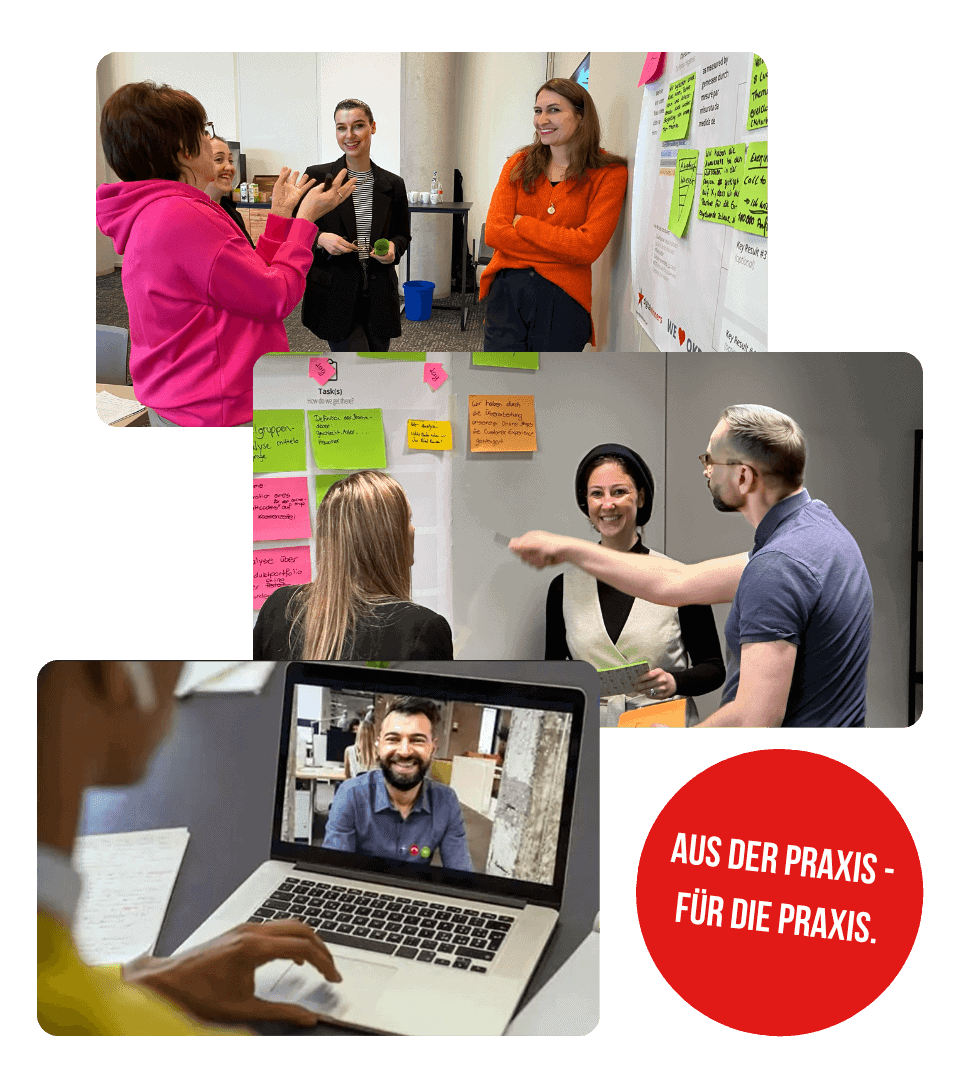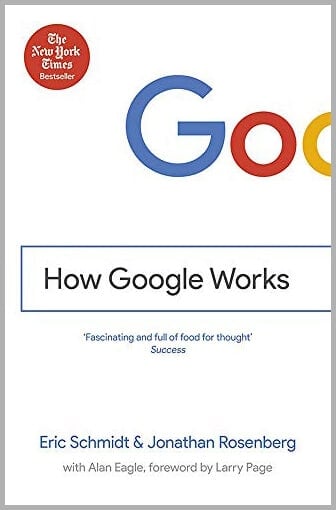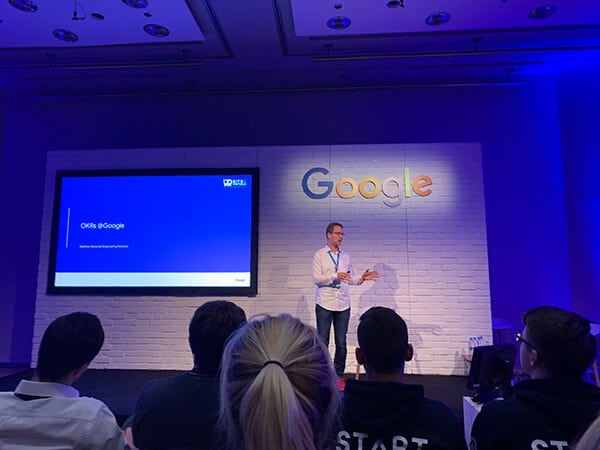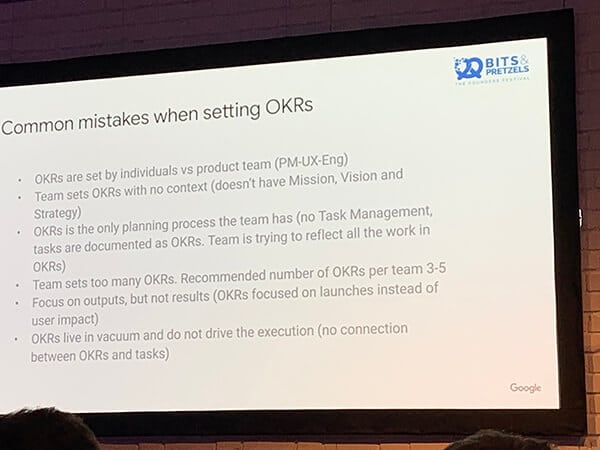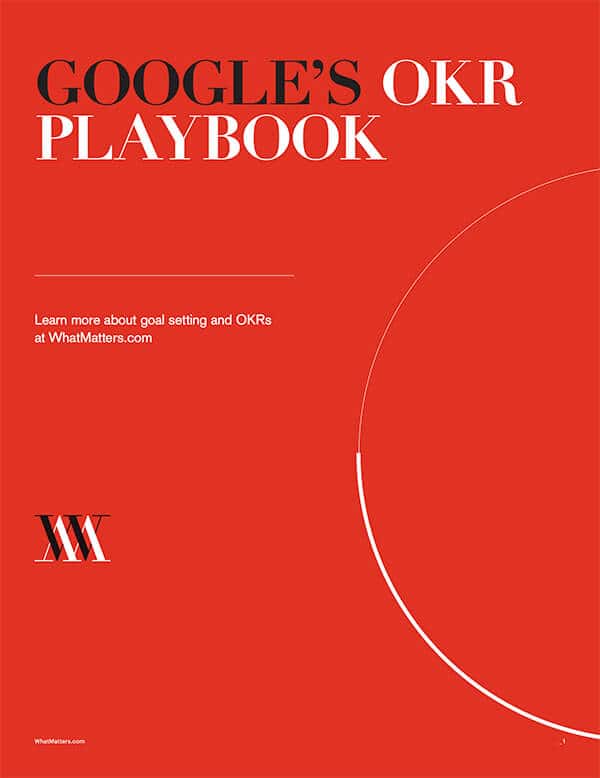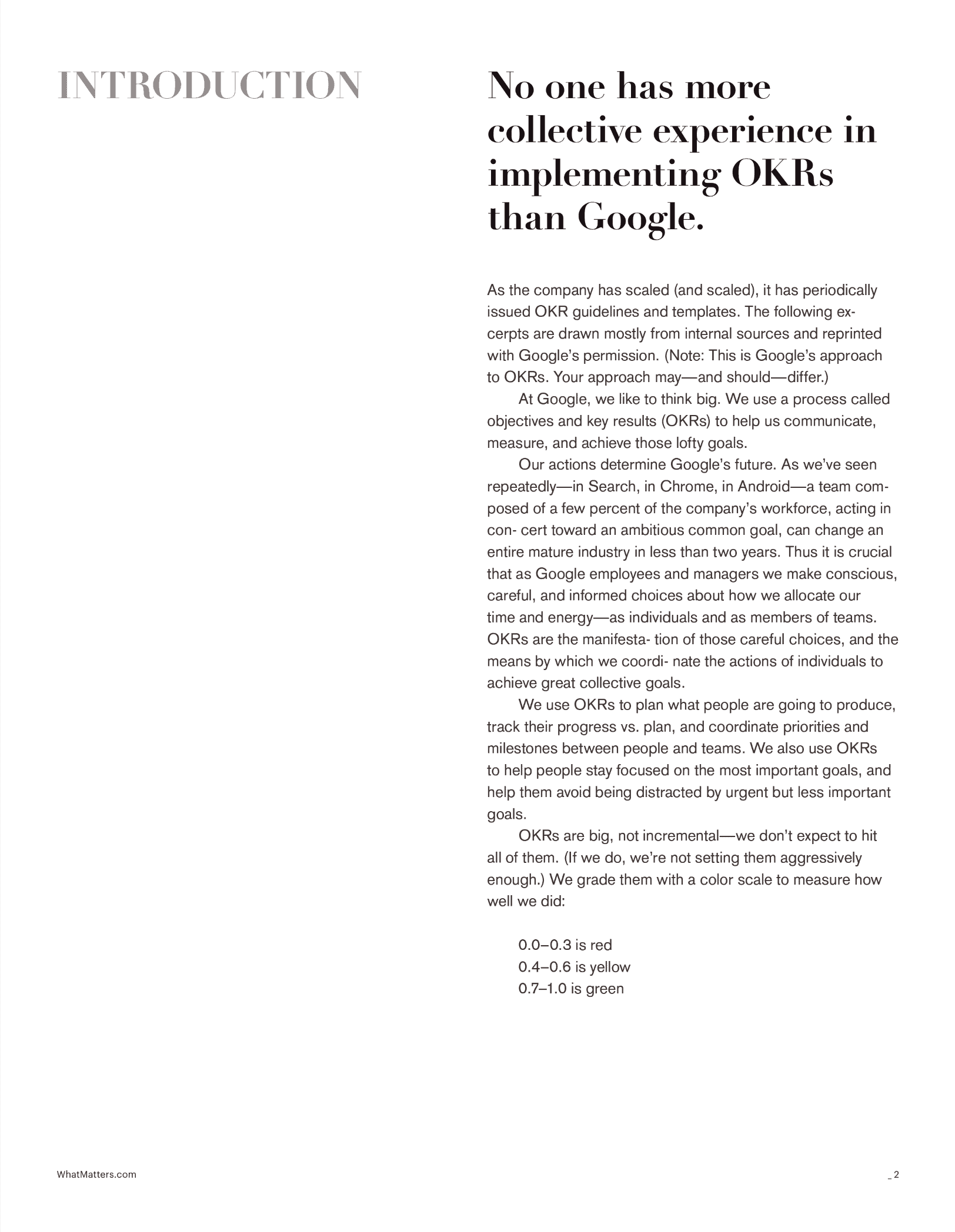Is OKR Google’s wonder weapon? How Google uses OKR
First we describe the history and then we provide insights into how OKR made Google successful:
The OKR method found its way to Google through an investment by the venture capital firm Kleiner Perkins (at that time still Kleiner Perkins Caufield & Byer).
Kleiner Perkins’ investment manager at the time was
John Doerr
who previously worked at Intel. There he learned from Andrew Grove – or Andy Grove, the founder of the OKR model, co-founder (“late founder”) and long-standing CEO of Intel – about the OKR method, which was based on the management method “Management by Objectives” (MbO). More about the OKR method – as well as how objectives and key results are created, how optimal objectives are created, making key results OKR measurable, what “ambitious goals” are, and much more. on the OKR examples page.
John Doerr introduced the OKR method at Google in 1999. On this page we describe the further exciting historical process of how John Doerr presented the topic of OKRs to the Google founders and provide links to interesting sources.
We also link to Google sources that provide insights into how Google uses OKR – and how OKR helps Google.
When John Doerr introduced Google OKR in 1999 – the introduction of the OKR method at Google
When John Doerr introduced the OKR method at Google in 1999, Google only had 40 employees.
The founders and executives of Google watch a presentation on OKR – Objectives and Key Results
Reconstruction of Doerr’s presentation – Copyright Steven Macdonald
Source: https://www.slideshare.net/philiplund/okr-john-doerr-original-slide-deck-from-1999
John Doerr showed Google founders Larry Page and Sergey Brin and the team a presentation on slides on an overhead projector. They gathered around the ping pong table (which doubled as a conference room) and he gave them his legendary presentation on the OKR framework.
Reconstruction of Doerr’s presentation – Copyright Steven Macdonald
Source: https://www.slideshare.net/philiplund/okr-john-doerr-original-slide-deck-from-1999
How the OKR Google Ventures video with Rick Klau made OKR known around the world
In 2012, Rick Klau from Google Ventures presented OKR in the video “How Google sets goals: OKR“. Since this publication, the OKR method has experienced a huge boost since its “invention” at Intel and has grown in popularity among companies of all sizes, contributing to their success: start-ups, scale-ups, SMEs and corporations – from LinkedIn to Lufthansa. Unfortunately, the content of the video is somewhat outdated in terms of OKR’s methodological approaches – at least in the meantime (more on this page below the video).
Here is the video from Google Ventures from 2012:

By loading the video, you agree to YouTube's privacy policy.
Learn more
In his presentation, Rick Klau unfortunately relies on the original presentation with which John Doerr introduced Google to OKR in 1999 – and he unfortunately presents OKR there as a purely top-down process for setting goals around output. Unfortunately, the bottom-up process and the theme outcome are not discussed. Unfortunately, he also speaks of only one or two check-ins per quarter – instead of OKR Weeklys. Unfortunately, Google never published a newer video. (More about the criminality of the video in Felipe Castro’s article: “Google’s OKR Video Should be Retired. Here’s Why.“)
Rick Klau only clarified certain points regarding OKR at the end of 2017 – see below.
OKR Trainings & Schulungen
Wir, die OKR-Experten, schulen Sie gerne mit unseren modernen Training-Formaten:
- Seminare in Präsenz & Remote
- Offene Schulungen & Inhouse-Seminare
- Workshops & Video-Kurse
How OKR has changed Google, contributed to the company’s success and developed Google OKR further
The new management approach has been further developed at Google over the years and is still a key driver of Google and Alphabet’s success today.
Eric Schmidt (CEO of Google from 2011 to 2015) and Jonathan Rosenberg (2002 to 2011 at Google, most recently Senior Vice President of Products) describe in their Book “How Google Works” (2014) – German title “Wie Google tickt – How Google Works”, that OKR is a “simple tool that let the founders institutionalize their ‘think big’ ethos” – is a “simple tool that allows founders to institutionalize their ‘think big’ ethos” – and how OKR has used Google.
You also state that Larry Page (CEO of Google at the time) posts his OKR sets every quarter and organizes a company-wide meeting to discuss them. They continue: “Operations managers join him on stage to discuss all OKRs and what they mean for their teams, and to assess their own performance against the previous quarter’s OKRs”.
How Google is practicing OKR five years after the video release – Rick Klau’s Lessons Learned on Twitter
At the end of 2017, Rick Klau published his lessons from the past via Twitter in a tweet stream (translated and shortened or supplemented):
- Omit individual OKRs – i.e. OKRs at employee level [i.e. targets for individual employees] – especially for younger, smaller companies. They are superfluous. Focus on OKRs at company and team level.
- Spend more time with the team that is prepared to say “no”. High-performing teams like to say “yes” to good ideas – but saying “no” is more important.
- Avoid metrics that quantify progress; focus on metrics that reflect the actual impact on the core of the business. Avoid metrics that show that you are busy but are not linked to the “outcome” (result, benefit) that the team [Teams und Mitarbeiter] wants to achieve.
- Keep it simple/simple/uncomplicated! Don’t get bogged down in the process.
- Select the most important things [aus dem Prozess]: Metrics that reflect success. Say “no” to everything else. Evaluate progress. Learning from mistakes. Repeat.
Rick Klau’s video from 2012 before his Lessons Learned on Twitter – see above.
Google OKR presentation at the Munich startup conference Bits&Pretzels 2019
We were able to attend a presentation by Google at Bits&Pretzels 2019, where Matthias Marschall, Engineering Director at Google, presented OKR in a breakout session – and how OKR helps Google to set goals correctly. On the right is a slide from the presentation with the“Common mistakes when setting OKRs“.
Photo: Presentation by Matthias Marschall, Engineering Director Google at Bits&Pretzels 2019 in Munich
Photo: Presentation by Matthias Marschall, Engineering Director Google at Bits&Pretzels 2019 in Munich
That was the legendary Bits&Pretzels 2019, where Barack Obama was the keynote speaker.
Als OKR Full-Service Agentur unterstützen Sie bei der OKR-Einführung und Optimierung – mit Beratung & Begleitung, OKR Seminaren & Workshops und bei der OKR-Software Auswahl.
Erno Marius Obogeanu-Hempel und unsere weiteren OKR-ExpertInnen
OKR-Einführung
OKR-Optimierung – Health Check
OKR-Training & OKR-Seminare
OKR-Workshops
OKR-Experten
OKR-Bücher
OKR-Vorträge
Zur Übersicht aller OKR-Angebote
Zur OKR-Experten Homepage
Oder rufen Sie uns an: +49 89 21 52 95 2 – 99
+43 720 02 21 68
+41 71 58 80 36 4
Als OKR Full-Service Agentur unterstützen Sie bei der OKR-Einführung und Optimierung – mit Beratung & Begleitung, OKR Seminaren & Workshops und bei der OKR-Software Auswahl.
Erno Marius Obogeanu-Hempel und unsere weiteren OKR-ExpertInnen
How Google uses OKR – an insight via John Doerr’s PDF: Google’s OKR playbook
John Doerr publishes on his website
Google’s OKR Playbook
– also as a PDF for download (via the “Download” button at the top left).
E-Book Cover – Copyright: John Doerr
E-Book Intro – Copyright: John Doerr
Setting goals correctly with focus – more Google OKR publications: Google re:work
The Google re:Work team has also provided further information on OKR.
re:Work is a division of Google dedicated to promoting and advancing the practice and research of data-driven human resources.
Here is a summary of the OKR Guide from Google re:work with small additions for better understanding (in square brackets).
Introduction to the Google re:work article
A goal can improve employee motivation. However, setting ambitious targets can increase employee commitment even more. Google often uses OKRs to set ambitious goals and track progress.
The OKR method according to Google at a glance
- Objectives are ambitious and can feel a little uncomfortable
- Key results are measurable and should be easy to rate with a number (Google uses a scale of 0 – 1.0)
- OKRs are public, so everyone in the organization can see what others are working on
- The “sweet spot” for goal grading [optimal goal achievement score| is 60% – 70%. If someone consistently achieves their goals completely [100%], their OKRs are not ambitious enough and they need to think about bigger goals
- A low rating means that the next OKRs should be refined [also besser erstellen soll]
- Objectives and key results are not synonymous with employee appraisals
- Goals and key results are not a shared to-do list
OKRs differ from other goal-setting techniques because you set [OKRs] very ambitious goals. According to Google, they help to focus on the essentials and achieve more than the team thought possible.
How Google uses OKR to achieve almost impossible goals
Unattainable goals are tricky, as a team could fail. However, big goals attract the best employees and create an exciting working environment. Moreover, even failed goals lead to considerable progress and success if you set yourself high goals.
Achieving 70% of the goals means success with Google. Fully achieving the OKRs [100%] is considered an exceptional achievement.
Such stretch targets are the building blocks for remarkable long-term achievements, the so-called “moonshots”.
Transparency as a success factor – how best to implement OKR in your company
Employee performance is higher when the OKRs are transparent. It is therefore important to get everyone involved on board.
Tips for introducing OKRs:
- What are OKRs? Explain what OKRs are and how they work.
- Why use OKRs? Review how the organization is currently approaching goal setting and what limitations or problems there are with this approach.
- How do OKRs work? Explain the timeline, what is expected of each person, what the key milestones are and how people will be held accountable.
- Are you still skeptical about OKRs? Allow time for questions, whereby the focus should be on eliminating any skepticism.
Alignment: Once the organization knows what it is focusing on and how it will measure success, it is easier for individual employees to link their projects to the company’s goals.
Discipline and prioritization: It is often difficult for a team in a company to reject a good idea, a worthwhile project or a necessary improvement. If everyone agrees on what the most important goals are, it is easier to say “no” to less important ideas. Saying “no” is then no longer a political or emotional debate, but a rational reaction to a commitment that the entire company has already made.
Communication: OKRs should be made public within a company so that every employee is aware of the company’s objectives and key performance indicators.
Set objectives and develop key results
When setting goals, Google often starts with the company’s OKRs. To this end, the team prioritizes three to five objectives with around three key results for each objective. People from across the organization can give their opinion on what your time is worth and how best to use their efforts.
In our blog post on the OKR method, we take a closer look at what objectives and key results are and how best to create them.
Avoid the following mistakes when writing OKRs
Poorly written OKRs can lead to a confusing strategy. According to Google, you should avoid these pitfalls when developing goals and key results:
Incorrect communication of stretch goals [moonshot or 10x goals, or extremely ambitious goals]. You should expect to achieve around 70% of these targets.
Business-as-usual. Some projects remain the same from quarter to quarter, such as “Ensure that customer satisfaction is above XX%”. That’s fine if this goal always has a high priority. Other goals, however, are written based on what the team believes it can achieve. Set objectives that focus on change. In addition, projects that the team or its customers really want should be achieved.
Sandbagging – Use all your team’s resources.
Low-value objectives – the OKR method always promises clear business value. Low value targets will not make a big difference to the company. Reformulate the OKR and focus on a tangible benefit.
Insufficient key results for objectives – Make sure that the achievement of all key results leads directly to the achievement of objectives. On the other hand, not enough resources are allocated to the OKRs and the target is not achieved on time.
OKR Seminar mit offizieller Zertifizierung zum OKR Coach / Master
Wir, die OKR-Experten, bilden Sie gerne zum OKR Coach / Master aus:
- in Präsenz & Remote
- Erlernen & Erleben der OKR-Methode
- Best Practices, Tipps & Tricks
Developing OKRs for teams – with benefits and results
Teams and individuals should set their intentions in the service of larger goals. So does every department need OKRs?
The organization’s objectives and key results do not have to be included in the working group’s OKRs. However, there should be a connection. One way to set the department’s goals and key results is to have all department heads come together.
At Google, team leaders sometimes list the priorities for the coming quarter in the context of the company’s OKRs.
If the number of employees is low, it is not necessary to create OKRs at employee level. Check the OKRs:
- Are the team priorities linked to the company’s key results?
- Do the team’s priorities increase the likelihood that the organization will successfully achieve the organizational OKRs [Unternehmens- / Top Level OKRs]?
- Are there things that are missing and that others think the team should work on?
- Are there more than three priorities?
OKRs are not a checklist [Taskliste]. Use OKRs to define the impact [Nutzen] the team wants to see and let the teams develop the methods to achieve that impact.
[Here you can find examples of OKRs]
Update Objective and Key Results regularly
According to Google, the OKRs are to be revised a few times per quarter. This allows everyone involved to adapt to new information and abandon goals that are clearly not being achieved.
The creation of the schedule depends on a number of internal factors. On the one hand, it depends on how good the communication within the team is. Secondly, how well the team is able to predict outcomes based on its ability to execute.
We are happy to support you with the introduction of OKR in your organization.
Questions and answers
When did Google introduce OKR?
Google introduced OKR in 1999. At the time, Google employed just 40 people. John Doerr convinced Google founders Larry Page and Sergey Brin and the team with an overhead slide presentation around a table tennis table. At the time, Doerr was an investment manager at the venture capital firm Kleiner Perkins, which invested in Google in 1999. John Doerr previously got to know OKR at Andy Grove, CEO Intel.
Who introduced OKR at Google?
John Doerr introduced OKR at Google – in 1999. At the time, Doerr was an investment manager at the venture capital firm Kleiner Perkins, which invested in Google in 1999. John Doerr previously got to know OKR at Andy Grove, CEO Intel. When OKR was introduced, Google only had 40 employees.
Where can I find the slides that John Doerr showed Google at the OKR launch?
There is a reconstruction of Doerr’s presentation at https://www.slideshare.net/philiplund/okr-john-doerr-original-slide-deck-from-1999.
How does Google implement the OKR method?
John Doerr has published Google’s OKR Playbook on his website and made it available for download as a PDF: https://www.whatmatters.com/resources/google-okr-playbook/
What are examples of OKRs on Google?
An example of an early Google OKRs: Objective: Become the best search engine in the world
Key Results: 1) Answer the most search queries of all search engines worldwide. 2) Customize the search so that it works in at least 10 languages. 3) Reduce the loading time for search results by at least 50%.
Source: Book “Measure What Matters” (2017), John Doerr


